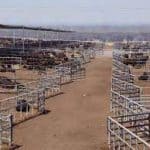
Choosing the best grain to feed your cows will help ensure that you and your livestock have a healthy diet. There are a few different grains available to you, and knowing which is best for your herd will ensure that your cattle get all the nutrients they need to perform at their best.
Contents
Barley
Whether you’re looking for a feed for beef or dairy cows, you’ll probably want to consider barley as a protein source. This grain provides rumen-degradable protein and energy and helps keep your ration balanced. It’s also an irreplaceable dietary component in dairy diets.
Barley is a cool season crop that can be harvested in 58 to 65 days. It has a fibrous hull that protects its proteins and endosperm.
The fiber coating of barley makes it more digestible than other grains. It’s also a great source of rumen-degradable protein, which is necessary for a healthy population of forage-digesting bacteria. It’s also a good supplement to be used with gestating cows on low-quality forage.
While there are advantages to feeding barley, there are some concerns. These include bloat, acidosis, and poor rumen health.
Oats
Using oats in the diet of cattle and sheep is becoming an increasingly popular strategy. This is because of their high fiber content and low energy value. Oats are also beneficial to the soil, promoting the health of the soil and water.
Oats are also considered to be a high quality feed for breeding and fattening animals. They have high nutrient levels and are a good source of oleic acid, which is a fatty acid that helps to improve the rumen health of cattle and horses. Using oats in the diet can also reduce the risk of digestive upsets.
The use of oats in the ration of beef cattle is increasing. In fact, it is now becoming the preferred grain for growing livestock. It is an ideal feed for weaned calves, providing the right amount of protein for growth.
Wheat
Whether you are feeding feedlot cattle, dry cows or replacement heifers, wheat is the best grain to feed your cows. This is because it has a good nutrient composition and is easily digested. However, you must know how to properly process and incorporate it into your ration.
The first step is to determine the moisture content and protein content of the wheat. Having the proper moisture value is important because wheat with low moisture values may be more susceptible to mycotoxin producing fungi.
In addition, you must evaluate the quality of the wheat bran. This is important because it is a source of minerals and amino acids. You also need to make sure that the grain is processed in a way that makes it more digestible.
Cottonseed
Using cottonseed in cow diets has many advantages. It provides a high energy source with higher concentrations of protein and fat than other supplements. It is also relatively inexpensive.
Whole cottonseed can be fed to cattle at several different stages of production. It has a unique nutrient profile and is a cost-effective premier feed. However, it has a few drawbacks.
Cottonseed meal is most commonly used to feed adult ruminants. It has a high protein content and a low residual oil ground. It also contains a small amount of lint. Its fiber content is important. It is also a good source of monogastric protein.
Unlike other feeds, cottonseed does not require processing before feeding. A minimum of 0.5 percent of the cow’s body weight should be fed in whole cottonseed each day. It is also advisable to mix with other components of the cow’s diet.
Triticale
Developed in the late 19th century, triticale is a hybrid of rye and wheat. It is a high-protein cereal that is suitable for grazing and silage. It is grown in over 30 states. The grain is used for feeding pigs, poultry, and horses.
The grains are highly digestible and contain high levels of starch and protein. They are also rich in essential amino acids. However, it is important to remember that triticale has a lower gluten content than wheat. This should be considered when processing the grain into fine particles.
It is also a good feed for dairy cows. It has a higher protein content than rye or wheat, which means it is easier for ruminants to digest.
Although it is usually harvested at the dough stage of maturity, it can also be baled and fed dry. It is also suitable for hay.



